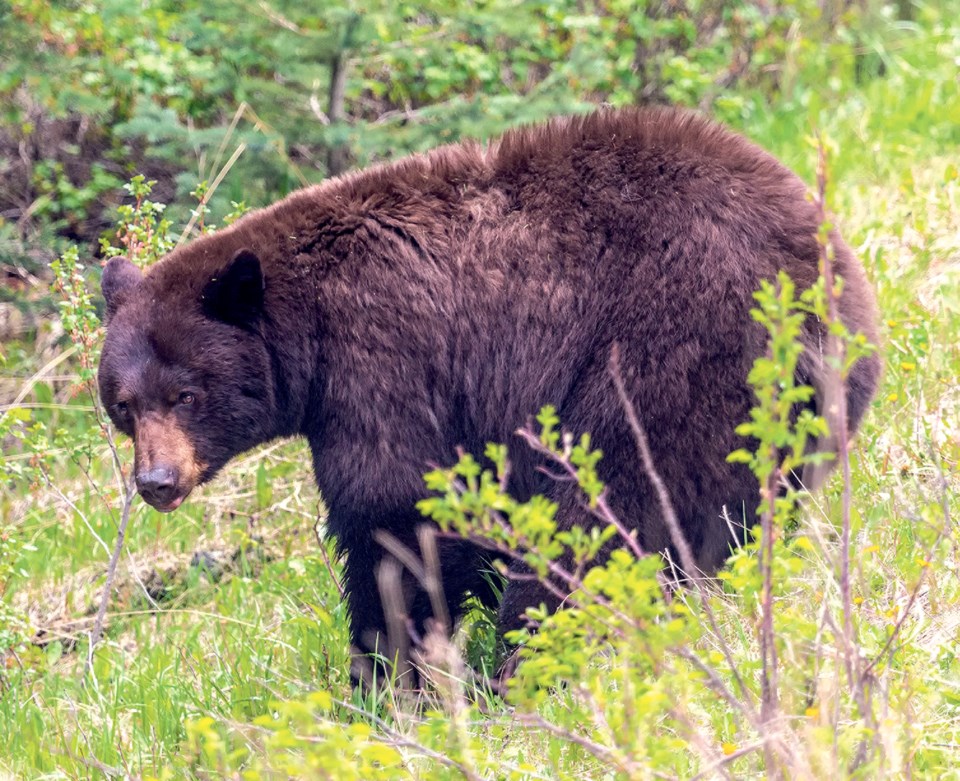CANMORE – Three black bears – a mama bear and her two cubs – were killed earlier this summer amid concerns for public safety as they fed on a buffet of dogwood in a Canmore residential neighbourhood.
Officials for Alberta Fish and Wildlife have repeatedly told the Outlook that no bears have been destroyed in Canmore so far this year, but finally confirmed this week that the bear family was destroyed back in August.
“We apologize for the error,” said Carla Jones, a spokesperson for Alberta Solicitor General and Justice – the ministry that oversees fish and wildlife – in an email.
Jones said six bears have been euthanized in the Cochrane district as of Oct. 18, which included the three bears in Canmore.
She said these numbers only include incidents that would fall under the jurisdiction of fish and wildlife officers.
“(It) does not include any bears that were relocated or euthanized in provincial parks,” she said.
The mama bear and her cubs were feasting on dogwood in the Rundle Plant Lane area near Canmore Creek. The food source has since been removed so as not to attract any more hungry bears to the area.
“They were getting into trouble, they were closing distance on people, bluff-charging,” Jay Honeyman, a human-wildlife conflict specialist with Alberta Environment and Parks, told CTV Calgary. “We caught them and they had to be destroyed.”
Jones said fish and wildlife officers use the provincial black bear response guide to determine how bears are handled.
“This guide provides a standard approach in deciding black bear management responses,” she said.
“The guide is a result of a collaboration among biologists, enforcement officers and problem wildlife specialists, and is reviewed annually and revised as required.”
Following the destruction of the three bears, Canmore has been on heightened alert with several other black bears feasting on backyard crabapple trees and mountain ash berries following a poor wild buffaloberry crop and an abundance of opportunity in town.
According to fish and wildlife, 23 bears have been captured throughout the Cochrane district, which includes Canmore and the Bow Valley.
Five black bears were relocated and shipped out of Canmore within one week at the end of September, including a sow and two cubs. Two black bears have been hit and killed on the Trans-Canada Highway.
Honeyman said it hasn't been a good year for bears, but in “reality it’s a very average year.”
“We’re moving these bears in the fall, which is just before denning, which is a terrible time to move bears. The success rate is really low,” he told CTV.
“There’s a lot of people in town who call themselves environmentalists and really care for wildlife… these are the people that are sending me pictures of bears on their back deck eating crabapples.”
Bear biologist Sarah Elmeligi said it’s important for residents to know many bears are being relocated out of Canmore or killed and how it compares year over year.
“It’s important for us to know how our actions as a community are being effective, or not effective, in keeping bears out of town and hopefully reducing the number of relocated bears,” she said.
“With a goal as a community to reduce human-wildlife conflict, if we’re not being successful, then we need to be able to take a step back and figure out some new actions to increase success.”
Elmeligi said it is vital for the community to get behind initiatives like removing wildlife attractants to help prevent bears from coming into town.
She said relocated bears typically don’t survive in the long-term.
The success rate is low because of challenges faced by bears in establishing themselves in new areas due to competition with other bears, foraging for food or denning for winter.
“The solution is to not be relocating as many bears, and the way that we do that is to change how we behave and how we manage our properties and our town,” she said.
“We need to make sure that when bears do come into town they don’t linger, they walk through town and continue on their merry way and no conflict results.”
However, Elmeligi did say the province’s bear response matrix in the response guide on black bear relocation is somewhat problematic because it is way too subjective.
“Unless the bear is engaging in its natural behaviour in its natural environment, then you can relocate… it’s like a quick option to come to,” she said.
“It’s important that these bear response matrixes provide consistency, that it doesn’t really matter who responds, that they would respond in the same way.”
Read more from RMOToday.com




